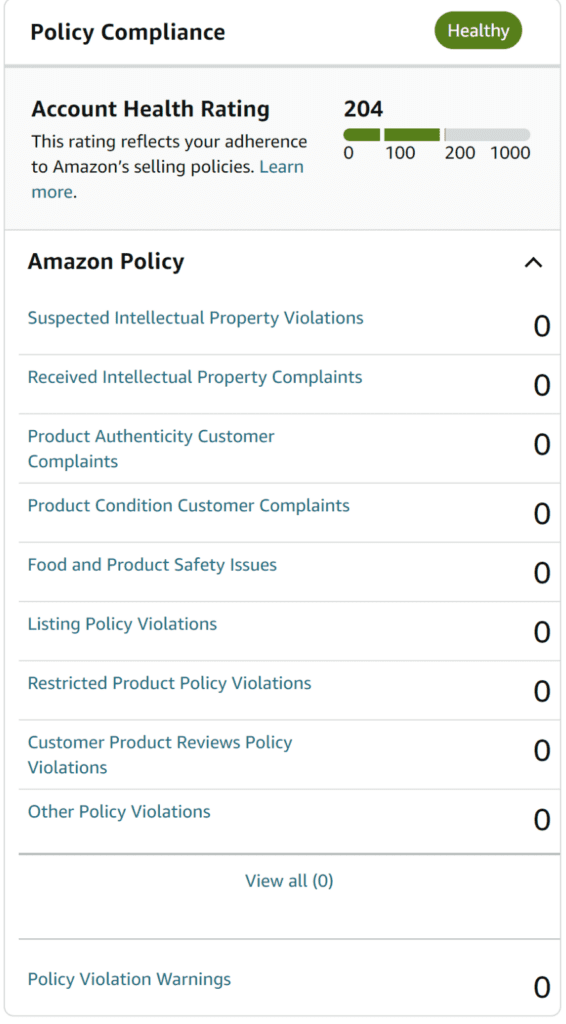Amazon don’t want to suspend seller accounts…but it’s a very real threat for sellers who don’t maintain their account health.
Let’s break it down so you can avoid the threat of account suspension:
What is Amazon Account Health?
Amazon Account Health is a system designed to evaluate a seller’s compliance with Amazon’s selling policies and customer service standards. It assesses various metrics including Order Defect Rate (ODR), Policy Violations, Shipping Performance, and Invoice Defect Rate (IDR) for Amazon Business customers. These metrics help gauge a seller’s performance on the platform.
Sellers can monitor their performance through the Account Health dashboard in Seller Central, which was updated in 2023 to emphasize how important maintaining high standards for customer experience is. The enhanced dashboard now offers a better picture for sellers to manage they’re complying with Amazon’s performance metrics and see their compliance status.
Where to find your Amazon account health
You can access your account health dashboard by navigating to Performance > Account Health in the Seller Central dropdown menu.

Your dashboard gives you full visibility of your seller account’s key metrics, including:
- Customer service performance
- Policy compliance performance
- Shipping performance
- Product compliance requests

This centralized view allows you to monitor and manage your performance effectively, ensuring you better adhere to Amazon’s standards and policies.
A Breakdown of the Amazon Account Health Rating (AHR)
The Account Health Rating (AHR) system is a critical component of your seller account health, indicating if an account is Healthy, At Risk, or Unhealthy through your status, points, and color.
AHR is measured in three colors that correspond to your health score which ranges from 0 to 1,000:
- Green = 200 to 1,000 points. Your account is healthy
- Orange = 100 to 199 points. Your account is at risk
- Red = 99 points or lower. Your account is at risk
This score updates in real-time so you can see the immediate impact on your account health if any policy violations occur.
Amazon distinguishes between four levels of severity for policy violations: critical, high, medium, and low.
Critical violations have the most severe impact, potentially leading to immediate account deactivation. Examples of the type of violation that fall into each severity level include:
- Critical = anti-counterfeiting policy violation
- High = brand name policy violation
- Medium = listing policy violation
- Low = product detail page rules violation
Amazon Account Health Metrics You Need to Know
Your account health is broken down into 3 main areas, each critical to maintaining a healthy seller account:
- Customer service performance
- Policy compliance
- Shipping performance
Optimizing each of these metrics is essentially all about ensuring a seamless shopping experience for your customers.
Customer Service Performance

Your customer service performance is made up of your Order Defect Rate (ODR) and Invoice Defect Rate (IDR). Let’s break them down:
Order Defect Rate
Order Defect Rate (ODR) measures customer feedback, A-to-Z guarantee claims, and chargeback claims to give an overview of the quality of a seller’s customer service. An order is considered defective if it results in negative feedback (2 stars or less), an A-to-Z guarantee claim that isn’t denied, or a chargeback claim.
Invoice Defect Rate
Invoice Defect Rate (IDR) measures the percentage of Amazon Business orders without the tax invoice uploaded within one business day of shipping. Sellers are targeted to keep their IDR below 5% or risk account suspension.
The goal is to maintain an overall ODR of less than 1% in a 60-day period.
Policy Compliance

Policy compliance covers Amazon’s guidelines around intellectual property issues, authenticity concerns, product conditions, and other policy violations. The goal is to target zero violations.
Protecting against these violations includes considerations like:
- Respecting the intellectual property rights of other brands and ensuring your listings don’t infringe on any of these rights
- Selling only genuine products – no fakes!
- Accurately describing the details and condition of your products to meet customer expectations and avoid disputes
Read more about Amazon product policy compliance and the appeals process for violations in our policy compliance blog post.
Shipping Performance

Shipping performance measures all of the metrics around whether your customers receive their orders promptly and accurately. Here’s a breakdown of what it measures:
Late Shipment Rate
Late Shipment Rate (LSR) applies only to seller-fulfilled orders and measures the percentage of orders confirmed for shipment after the expected ship date. To maintain a healthy account, your LSR should be below 4%.
Valid Tracking Rate
Valid Tracking Rate (VTR) applies only to seller-fulfilled orders and measures the percentage of total shipments with a valid tracking number provided. A VTR above 95% in a 30-day period is considered a healthy rate. Utilizing trackable shipping methods and keeping inventory up-to-date are key strategies for achieving this target.
Pre-Fulfillment Cancelation Rate
Pre-Fulfillment Cancelation Rate measures the percentage of orders canceled by the seller before shipping.
Return Dissatisfaction Rate (RDR)
A final metric affecting account health is the Return Dissatisfaction Rate (RDR), which measures customer satisfaction with the return process.

Strategy Time: How to Improve Your Amazon Account Health
Adhere to Amazon’s Selling Policies
This sounds obvious but Amazon’s compliance policies are strict, so proactively managing your adherence to them is essential.
Ensure On-Time Delivery
While Amazon has FBA sellers covered, you’re responsible for the on-time delivery of your Fulfilled by Merchant (FBM) orders. If your shipping times are slipping, consider using Amazon’s Buy Shipping services or one of their integrated carriers to improve shipping performance.
Use Adequate Packaging and Trackable Shipping Methods
Ensuring on-time delivery is closely followed by the other factors to ensure the highest quality shipping service: opting for trackable shipping methods and adequate packaging. They both help avoid chargeback claims and as a result, directly impact your VTR and overall shipping performance.
Always Accurately Represent Products
Accurate product listings with clear images and descriptions are essential to not only ensure you never mislead customers, but also to help prevent negative feedback and A-to-Z guarantee claims.
Promptly Respond to Customer Messages
Aim to respond to customer questions and concerns within 24 hours. Quick and effective communication can resolve potential issues before they escalate into the negative feedback or claims that would affect your account health.
Use tools like the Amazon Seller App and SellerApp to ensure you or your team are receiving alerts when customers contact you so you can be as responsive and helpful as possible.

Proper Inventory Management
For FBM products, ensuring your inventory levels are accurate helps avoid cancellations due to out-of-stock items. This should be a regular part of your inventory management strategy.
Inventory management for FBA works a little differently to FBM, so we’ve got a whole blog post on Amazon FBA inventory management.
Review Your Product Listings Regularly
Like all of the other tips, this is about being proactive. Regularly reviewing product listings for compliance and removing any restricted products are proactive steps to avoid violations that could affect your account health.
Also, pay attention to your product reviews. They can be a goldmine of insight into how your customers felt when they received their order – if customers feel misled, they will write about it and you should listen and adjust accordingly.
All of these proactive strategies will contribute to you maintaining a strong account health score.
What Happens if Your Amazon Account Health Decreases?
A decrease in your account health can have serious consequences for your Amazon business. Here’s what can happen if your account health deteriorates:
1. Warnings and Account Suspension
A decline in your account health can lead to three consequences: a warning from Amazon, account suspension, or even removal from the platform entirely.
2. Request for Plan of Action (POA)
Amazon may request a POA for improvement within 48 hours if any of your metrics fall below targets. This step is crucial in demonstrating your commitment to resolving the issues and restoring your account health to provide the best service to Amazon customers.
3. Withholding of Funds and Restricted Selling Privileges
Failure to address issues promptly or provide your POA to Amazon can result in the temporary withholding of funds and restricted selling privileges.
4. Account Deactivation
Account deactivation usually only occurs due to critical policy violations or if the seller fails to improve metrics after warnings. Using the appeals process and providing any necessary documentation to support your appeal can help address policy violations and restore your account status.
5. Reinstating Your Account
Reinstatement is possible if a seller successfully addresses any violations and demonstrates an understanding and clear willingness to rectify the situation.

Amazon’s Account Health Assurance
The last thing Amazon want to do is deactivate seller accounts. It’s in everyone’s interest – sellers, Amazon, and the customers – for sellers to adhere to the policies and maintain a strong account health.
That’s why Amazon’s Account Health Assurance (AHA) is a program to help eligible sellers maintain the health of their accounts so that they can continue selling even when facing issues that may otherwise lead to account deactivation. Here’s how it works:
If enrolled sellers face an issue that would usually lead to account deactivation, Amazon will not deactivate the account. Instead, sellers can continue selling while simultaneously working one-on-one with a member of the Amazon team to resolve the problem.
This personalized support is aimed at helping sellers get back on track, addressing any issues that could impact their account health, and is part of Amazon’s broader efforts to support sellers so that they can provide the best service to Amazon customers.
A program that creates a better environment for sellers and removes the threat of immediate account suspension can only be a positive for sellers on Amazon, right?
For more on Amazon’s Account Health Assurance program, read the next blog in this series to find out how it works and how to enroll.
What’s insurance got to do with it?
Explore pay monthly product liability insurance that scales up and down with your Amazon sales – so even in the face of account suspension, you’ll never be overinsured.




0 Comments